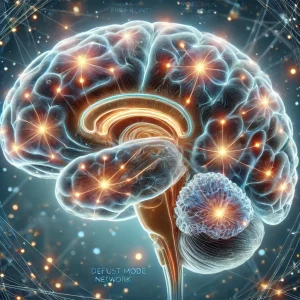ADHD and the Default Mode Network
What is the Default Mode Network (DMN)?
The Default Mode Network (DMN) is a network of interconnected brain regions that is most active when the mind is at rest, such as during daydreaming, introspection, or mind-wandering. This network plays a critical role in self-referential thoughts, memory retrieval, and envisioning the future. In people with ADHD, the DMN can be overactive, leading to difficulties in switching from a resting state to focused attention.
The Role of the Default Mode Network in ADHD
DMN Overactivity in ADHD
Research has shown that individuals with ADHD often experience overactivity in the Default Mode Network. This heightened activity makes it challenging to transition from a state of rest to a state of focus. The brain struggles to "switch off" the DMN when it needs to engage in tasks requiring attention, leading to distractibility and difficulties with concentration.
Impact of DMN on Attention and Focus
The overactivity of the DMN is a significant factor in the attention and focus issues commonly associated with ADHD. When the DMN is too active, it becomes difficult for individuals to maintain sustained attention on tasks. This can result in frequent mind-wandering, difficulty staying on task, and challenges in completing assignments or following through with plans.
How the Default Mode Network Affects Daily Life for Those with ADHD
Daydreaming and Distractibility
One of the most noticeable effects of an overactive DMN in people with ADHD is a tendency toward daydreaming and distractibility. The mind frequently drifts away from the task at hand, making it hard to stay present. This constant mental drifting can be frustrating, leading to difficulties in both academic and work environments where sustained attention is crucial.
Challenges with Task Initiation and Completion
For individuals with ADHD, initiating and completing tasks can be particularly challenging due to the DMN's influence. The overactive DMN can cause procrastination, as the brain remains in a restful, introspective state rather than shifting into a productive mode. This often leads to unfinished projects, missed deadlines, and a constant feeling of being overwhelmed.
Managing the Default Mode Network in ADHD
Mindfulness and Meditation
Mindfulness and meditation are effective strategies for managing the Default Mode Network's overactivity in ADHD. These practices help train the brain to stay in the present moment, reducing the tendency for the mind to wander. Regular mindfulness practice can help individuals with ADHD better manage their attention and reduce the impact of DMN-related distractions.
Cognitive Behavioral Therapy (CBT)
Cognitive Behavioral Therapy (CBT) is another effective approach for managing DMN-related symptoms in ADHD. CBT helps individuals identify and challenge negative thought patterns, which are often exacerbated by an overactive DMN. Through CBT, individuals can learn to redirect their focus and develop healthier, more productive thought processes.
Medication and Its Effects on DMN
Medication, particularly stimulant medications, can play a crucial role in regulating DMN activity in individuals with ADHD. These medications help to balance the neurotransmitters in the brain, reducing DMN overactivity and improving focus and attention. While medication is not a cure, it can significantly alleviate symptoms and enhance the effectiveness of other treatment strategies.
The Future of ADHD Treatment and DMN Research
Emerging Studies on DMN and ADHD
Recent research into the relationship between ADHD and the Default Mode Network is opening new avenues for treatment. Scientists are exploring how targeted therapies can modulate DMN activity, potentially offering more effective and personalized treatment options for individuals with ADHD.
Personalized Treatment Approaches
As our understanding of the DMN and its role in ADHD grows, so does the potential for personalized treatment approaches. Tailoring treatment plans to the specific needs of each individual, including strategies to manage DMN overactivity, is becoming increasingly important in ADHD care. This holistic approach can improve outcomes and help individuals lead more focused and fulfilling lives.
Conclusion
Integrating DMN Management into ADHD Treatment
The Default Mode Network plays a critical role in the challenges faced by individuals with ADHD. Understanding this connection and implementing strategies to manage DMN overactivity can significantly improve focus, attention, and overall quality of life.
By combining mindfulness practices, neurodivergent affirming cognitive behavioral strategies, medication, and personalized treatment approaches, individuals with ADHD can better navigate their daily lives and achieve their own personal goals.

It's important to work closely with a healthcare provider to determine if medication is appropriate and to find the right type and dosage. Medication should be seen as one part of a comprehensive treatment plan that includes therapy, coaching, and lifestyle changes.




